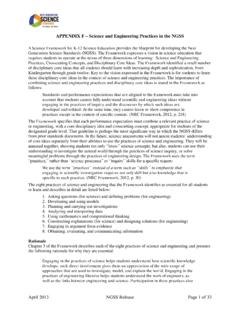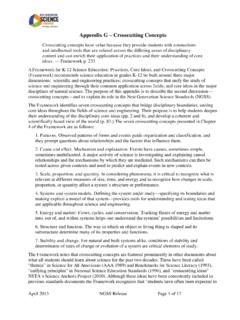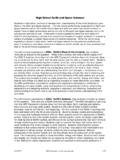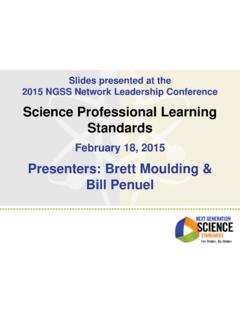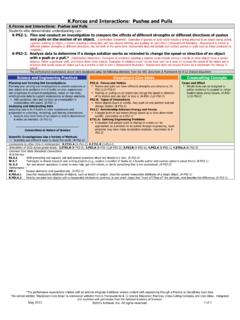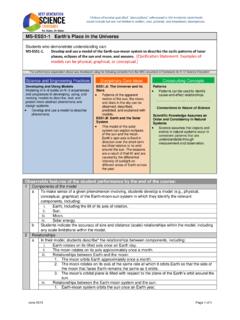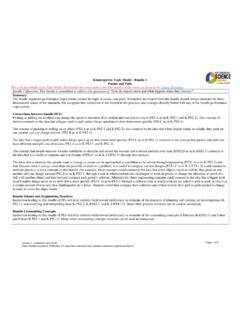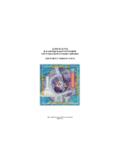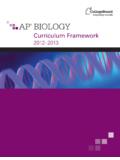Transcription of Key Definitions - nextgenscience.org
1 April 2013 NGSS Release Page 1 of 7 APPENDIX I Engineering Design in the NGSS The next generation Science Standards (NGSS) represent a commitment to integrate engineering design into the structure of science education by raising engineering design to the same level as scientific inquiry when teaching science disciplines at all levels, from kindergarten to grade 12. There are both practical and inspirational reasons for including engineering design as an essential element of science education. We anticipate that the insights gained and interests provoked from studying and engaging in the practices of science and engineering during their K-12 schooling should help students see how science and engineering are instrumental in addressing major challenges that confront society today, such as generating sufficient energy, preventing and treating diseases, maintaining supplies of clean water and food, and solving the problems of global environmental change.
2 (NRC 2012, p. 9). Providing students a foundation in engineering design allows them to better engage in and aspire to solve the major societal and environmental challenges they will face in the decades ahead. Key Definitions One of the problems of prior standards has been the lack of clear and consistent Definitions of the terms science, engineering, and technology. A Framework for K-12 Science Education has defined these terms as follows: In the K 12 context, science is generally taken to mean the traditional natural sciences : physics, chemistry, biology, and (more recently) earth, space, and environmental sciences .
3 We use the term engineering in a very broad sense to mean any engagement in a systematic practice of design to achieve solutions to particular human problems. Likewise, we broadly use the term technology to include all types of human-made systems and processes not in the limited sense often used in schools that equates technology with modern computational and communications devices. Technologies result when engineers apply their understanding of the natural world and of human behavior to design ways to satisfy human needs and wants. (NRC 2012, p. 11-12) The Framework s Definitions address two common misconceptions.
4 The first is that engineering design is not just applied science. As described in Appendix F: Science and Engineering Practices in the NGSS, the practices of engineering have much in common with the practices of science, although engineering design has a different purpose and product than scientific inquiry. The second misconception is that technology describes all the ways that people have modified the natural world to meet their needs and wants. Technology does not just refer to computers or electronic devices. The purpose of defining engineering more broadly in the Framework and NGSS is to emphasize engineering design practices that all citizens should learn.
5 For example, students are expected to be able to define problems situations that people wish to change by specifying criteria and constraints for acceptable solutions; generating and evaluating multiple solutions; building and testing prototypes; and optimizing a solution. These practices have not been explicitly included in science standards until now. April 2013 NGSS Release Page 2 of 7 Engineering Design in the Framework The term engineering design has replaced the older term technological design, consistent with the definition of engineering as a systematic practice for solving problems, and technology as the result of that practice.
6 According to the Framework: From a teaching and learning point of view, it is the iterative cycle of design that offers the greatest potential for applying science knowledge in the classroom and engaging in engineering practices (NRC 2012, pp. 201-2). The Framework recommends that students explicitly learn how to engage in engineering design practices to solve problems. The Framework also projects a vision of engineering design in the science curriculum, and of what students can accomplish from early school years to high school: In some ways, children are natural engineers. They spontaneously build sand castles, dollhouses, and hamster enclosures, and they use a variety of tools and materials for their own playful purposes.
7 Children s capabilities to design structures can then be enhanced by having them pay attention to points of failure and asking them to create and test redesigns of the bridge so that it is stronger. (NRC, 2012, p. 70). By the time these students leave high school, they can undertake more complex engineering design projects related to major global, national, or local issues (NRC, 2012, p. 71). The core idea of engineering design includes three component ideas: A. Defining and delimiting engineering problems involves stating the problem to be solved as clearly as possible in terms of criteria for success, and constraints or limits.
8 B. Designing solutions to engineering problems begins with generating a number of different possible solutions, then evaluating potential solutions to see which ones best meet the criteria and constraints of the problem. C. Optimizing the design solution involves a process in which solutions are systematically tested and refined and the final design is improved by trading off less important features for those that are more important. It is important to point out that these component ideas do not always follow in order, any more than do the steps of scientific inquiry. At any stage, a problem-solver can redefine the problem or generate new solutions to replace an idea that just isn t working out.
9 Engineering Design in Relation to Student Diversity The NGSS inclusion of engineering with science has major implications for non-dominant student groups. From a pedagogical perspective, the focus on engineering is inclusive of students who may have traditionally been marginalized in the science classroom or experienced science as not being relevant to their lives or future. By asking questions and solving meaningful problems through engineering in local contexts ( , watershed planning, medical equipment, instruments for communication for the Deaf), diverse students deepen their science knowledge, come to view science as relevant to their lives and future, and engage in science in socially relevant and transformative ways.
10 From a global perspective, engineering offers opportunities for innovation and creativity at the K-12 level. Engineering is a field that is critical to undertaking the world s challenges, and April 2013 NGSS Release Page 3 of 7 exposure to engineering activities ( , robotics and invention competitions) can spark interest in the study of STEM or future careers (National Science Foundation, 2010). This early engagement is particularly important for students who have traditionally not considered science as a possible career choice, including females and students from multiple languages and cultures in this global community.

